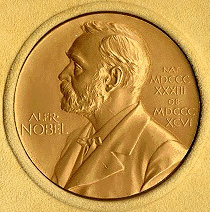|
At the Rockefeller University I worked closely with two scientists who received Nobel Prizes based on the work accomplished in the laboratory: 1974 Nobel Prize in Medicine - I contributed to scientific work honored in the Nobel Prize awarded to Dr. George E. Palade in 1974. This work defined the functional relationship between intracellular compartments that define the regulated secretory pathway in human cells. 1999 Nobel Prize in Medicine - I served as the primary initial collaborator in the seminal scientific work honored in the Nobel Prize awarded to Dr. Günter Blöbel in 1999. Shortly after the prize was announced I summarized my participation in the effort as follows: "The Scientific work that I performed at the Rockefeller University between 1970 and 1983, together with the work of others, was honored in the Nobel Prize in Medicine yesterday. The recipient of the prize is Dr. Günter Blöbel, senior member of the research team. The prize awarded by the Nobel Committee of the Royal Swedish Academy of Science in Stockholm, was announced in the October 12, 1999, issue of the New York Times. The body of work established the existence of peptide signals that direct the transport of subgroups of proteins into specific cellular compartments, e.g. those that are destined to be secreted from the cell. Secretory proteins perform valuable functions as digestive enzymes in the gastrointestinal tract, as hormones in intercellular communication and as binding proteins in the transport of solutes through the blood circulation. The prize honors, in part, the studies that initially defined the N-terminal signal peptide responsible for targeting proteins to the secretory pathway of the cell. The first signal peptide to be discovered was that for pancreatic trypsin, a digestive enzyme responsible for the breakdown of protein in the diet. The seminal work was published in the Proceedings of the National Academy of Science in 1975 (Devillers-Thiery, A., Kindt, T., Scheele, G., and Blöbel, G. Homology in the amino-terminal sequence of precursors to pancreatic secretory proteins. Proc. Nat'l Acad. Sci., USA, 72: 5016-20). Work which established the membrane model was published in the European Journal of Biochemistry (Scheele, G., Dobberstein, B. and Blöbel, G. Transfer of proteins across membranes. Biosynthesis in vitro of pretrypsinogen and trypsinogen by cell fractions of canine pancreas, Eur. J. Biochem. 82: 593-9, 1978). The average human cell contains one billion proteins involved in a myriad of diverse processes including cell division, energy metabolism and protein secretion. The role of signal peptides in directing the traffic of proteins to their correct locations (addresses) within cells became the central tenet of the "signal hypothesis". In the period from 1975 through 1983 my laboratory published a series of papers (see Bibliography) reporting on the underlying biochemical processes that helped to establish the signal hypothesis. The seminal nature of the work performed at the Rockefeller University in the 70s and early 80s helped to launch the fields of protein trafficking and Molecular and Cellular Biology, which have emerged on an international scale." George A. Scheele, M.D. ALSO SEE UNDER SCIENTIST
|
||

